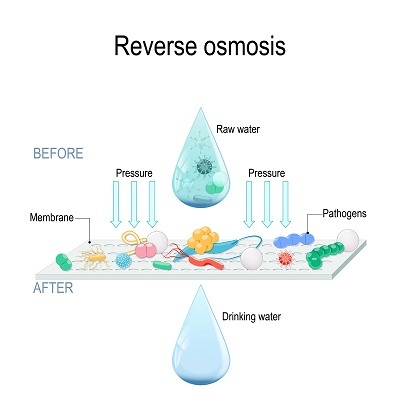
 Data Structure
Data Structure Networking
Networking RDBMS
RDBMS Operating System
Operating System Java
Java MS Excel
MS Excel iOS
iOS HTML
HTML CSS
CSS Android
Android Python
Python C Programming
C Programming C++
C++ C#
C# MongoDB
MongoDB MySQL
MySQL Javascript
Javascript PHP
PHP
- Selected Reading
- UPSC IAS Exams Notes
- Developer's Best Practices
- Questions and Answers
- Effective Resume Writing
- HR Interview Questions
- Computer Glossary
- Who is Who
RO: Reverse Osmosis
Introduction
Water is absorbed by plant roots from the soil and by human kidneys from the blood as examples of osmosis. Osmosis occurs without the need for energy in a natural way, but it requires energy to reverse the process. A semi-permeable membrane is impermeable to the majority of dissolved salts, organics, microorganisms, and other contaminants.
What is Reverse Osmosis?
Water is demineralized or deionized via the reverse osmosis technique, often known as RO, which involves forcing the water under pressure through a semi-permeable Reverse osmosis Membrane. You must first comprehend the naturally occurring process of osmosis in order to comprehend the goal and mechanics of reverse osmosis. One of the most significant processes in nature, osmosis is a phenomenon that happens spontaneously. Weaker salt solutions will typically move to stronger salt solutions throughout this process.

How Reverse Osmosis Works ?
To do a straightforward experiment, gather some freshwater and a concentrated aqueous solution. To keep the two solutions apart and on distinct sides, a semipermeable membrane should be positioned between them. Put pressure on the area where the concentrated solution is located. As a result, water molecules will now cross the membrane and land on the freshwater side. In essence, this is how reverse osmosis functions.
Low-pressure (Residential) System
Water filtration systems for houses that use reverse osmosis remove contaminants from drinking water. In household reverse osmosis (RO), pollutants are removed from your drinking water using a semipermeable membrane. The water pressure in your home pushes incoming water across a special membrane, which effectively filters out a large number of impurities. Reverse osmosis may remove germs, lead, nitrates, total dissolved solids, and many other undesirable substances from your drinking water (RO).
What are the Stages of Reverse Osmosis(RO) Systems for Homes?
Pre-Filter
A reverse osmosis (RO) system's pre-filter, also known as a sediment filter, is intended to filter out big particles from entering the water in order to safeguard the membrane.
Cartridge Filter
A reverse osmosis (RO) system's carbon filter eliminates organics and chlorine from entering the water. It is possible to use one or more carbon filters to stop chlorine from harming the membrane.
Membrane for Reverse Osmosis (RO)
The membrane for reverse osmosis (RO) is semipermeable. This indicates that it lets essentially clean water pass through while removing undesired impurities.
Holding Tank
So that you always have access to clean, refreshing drinking water, reverse osmosis (RO) storage tanks hold cleansed water.
Filter after
A reverse osmosis (RO) system's post filter gets rid of any taste or odor that remains after storage.
High-pressure (Commercial) System
Water from sources like lakes, rivers, and wells is purified by skid-mounted commercial reverse osmosis purifiers. A high-pressure pump is used in a commercial RO system to pressurize brackish or saltwater against the surface of a semi-permeable membrane with tiny holes. Only water molecules are allowed to travel through the tiny pores, while salt, particles, minerals, and other organics are prevented from doing so. These tiny holes are quite effective at rejecting bacteria and pathogens that cause sickness. Salts, minerals, and other organic matter are discharged into the brine stream and subsequently down a drain at the conclusion of this process, leaving only clean, purified water on the side with lower pressure.
Conclusion
Reverse Osmosis is a method that uses pressure to force water through a semi- permeable membrane. It allows clean water to pass through while keeping most impurities at bay, a process known as desalination (demineralization or deionization) of water. Reverse osmosis (RO) is the process by which water is purified from organic impurities such as bacteria, lead, nitrates, and many other undesired pollutants in your drinking water. A semi-permeable membrane is used to allow clean water to pass through while removing undesired impurities.
FAQs
Q1. What drawbacks do reverse osmosis have?
Ans: The disadvantage of RO water is that it might considerably lower the beneficial minerals that are necessary for the heart and muscles' general health. Reverse osmosis users may experience adverse effects including fatigue, cramping in the muscles, general weakness, and, in severe cases, cardiovascular issues.
Q2. What are the benefits of reverse osmosis?
Ans: Here are some of the advantages of reverse osmosis
Many different kinds of dissolved and suspended chemical particles, as well as biological agents, can be successfully removed from water using this method.
This method is widely used to remediate liquid discharges or pollutants.
It helps to prevent disease by purifying water.
It aids in seawater desalination.
The medical industry benefits from it.
Q3. What is the reverse osmosis principle?
Ans: Reverse osmosis (RO) water filtration removes ions, undesirable substances, and bigger particles from drinking water using partially permeable membranes. This keeps the solute on the membrane's pressurized side while allowing the pure solvent to pass through to the other side.

